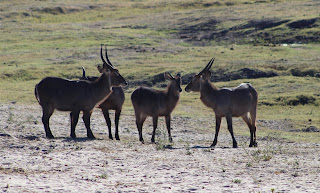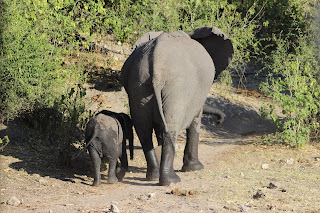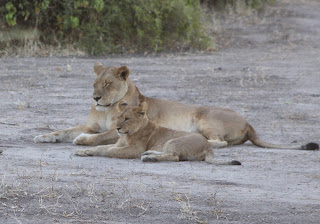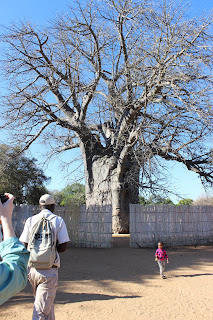On the Road Again - to Southern Africa! Post Three: Botswana
Post 3: Botswana and Namibia
On day seven of our adventure, after visiting the Chinotimba Primary School in Victoria Falls, we headed on to Kasane, Botswana, a two-hour drive away. Kasane is just outside Chobe National Park, Botswana's first game reserve and home to the largest herd of elephants in the country, as well as the lions who eat them. During our three days there, we spent most of our time in the park, either in open-sided safari vehicles or in a boat.
There is only one lodge inside the park, so we stayed at the Chobe Marina Lodge, just down the Chobe River. The wildlife experience starts at the lodge, where monkeys call out from the trees and wart hogs stroll companionably down the walkways. An avid birdwatcher could sit on the porch outside the rooms and fill out a great list without leaving the chair.
Our game drives started at 6 am, while it was still dark, and began with a high-speed drive through 40° winter mornings, wrapped in blankets against the cold. Along the road, we drove by all the folks who walk long distances from villages to work in the lodges and businesses of Kasane. Besides heralding the beginning of winter, June is the heart of dry season in southern Africa. This is a hard time for the animals, who must congregate around smaller and smaller watering holes or make the trek to the banks of the river to drink. For the safari visitor, though, it offers amazing opportunities to see wildlife in huge numbers as they gather at the water.
After unloading our bags from the van and checking into our rooms, we had a quick lunch at the hotel and headed out for our first game drive. Chobe is amazing. The "roads" through the park are made of Kalahari Desert sand, and vehicles bounce and jounce and spin their wheels as they go over the little hills of the river valley. Almost immediately, we saw the graceful rare puku antelope that only live in Chobe, along with three male waterbuck, another antelope with a "follow me" target on their rear ends. Later in the day, these were joined by the endangered red lechwe and the majestic hump-backed kudu.


And oh, the elephants! I have WAY too many pictures of elephants from Chobe; I discovered there is almost no way to get a bad shot of these photogenic beauties. Here are a few from that first day:
Of course there are other animals in Chobe, too – hippos and giraffes and zebras and lions and countless amazing birds.
The next several days were spent climbing in and out of safari vehicles, bouncing over the Kalahari sand tracks. On the second day, we found the king – well, the queens – of the savanna. After hours of finding their tracks in the sand, we finally came across a group of female and young lions resting among some yellow flowers and low scrub. They watched the vehicles, but seemed un-bothered by human presence in their siesta spot. It was a delight to watch them
The second afternoon, we took a river boat trip, getting a chance to see the animals from the water, including several magnificent Cape buffalo. While on the water, our guide Joseph noticed that a herd of elephants were planning to cross the river. We waited, and soon were rewarded by the sight of dozens of elephants descending into the river for the dangerous crossing (crocodiles are always on the lookout for young). The babies were tucked safely between their elders, and disappeared under the water midstream, only their trunks like periscopes visible above the surface, to resurface on the other side. I can't tell you what we had to eat and drink on the boat, but the wildlife were mesmerizing - even the 12-foot crocodile, who was clearly fantasizing about having us for a snack.
A Visit to a Namibian Village
Kasane is located in the northeast corner of Botswana, where four countries come together to meet the Zambezi River: Botswana, Zambia, Zimbabwe and Namibia. Namibia is represented here by a narrow spit of land, Caprivi Strip, that stretches across the top of Botswana to reach the Zambezi, which at one point was thought would give the German colonizers of Namibia access to the Pacific Ocean (before they discovered that Victoria Falls blocked the way rather decisively). It was to that strip - specifically, Impalila Island - that we headed on our third day in Botswana.
The trip across the Chobe River by small motorboat was quick: we could see the destination from our hotel. A stop at the Botswana government house for exit stamps on our passports and we were on our way. On our arrival, we stopped again at the Namibia government house for entrance stamps, and then set out on foot to Kafubu village.
Our guide, David, is from a nearby village and works for the Impalila Conservancy, helping to preserve the local culture through careful tourism and education. He said he had left town to get an education, but was delighted to have a chance to make a living and live near where he grew up. After a mile-long walk, he took us into the village, built around an ancient banyan tree, and introduced us to Alfred, who welcomed us into his family compound and showed us how the Sudia people live. A small solar panel in Alfred's yard charges one light and the family's cellphones. The island has no electricity, no doctor, and no school beyond the primary level. People who work in neighboring Botswana have to commute via a small boat, checking in and out of customs offices daily. Some women from the village had set up a small craft fair of local baskets and carvings for us to buy.
David told us that village culture is still strong, no matter how far away community members have to go to work. He described a network of elders - uncles and aunts who are responsible for making sure young people follow accepted behavior. If he went 100 miles away and treated someone with disrespect, he said, his uncles would hear about it, and would tell his parents and call him out.
David and our group on the way to Kafubu
A villager walking to the river
Coming into Kafubu village
Alfred's family kitchen
Drying rack
Solar power
Alfred and his grandson
A village house - sealed with mud from termite mounds
Village crafts for sale
Yes, we bought this beautiful basket
The morning commute from Impalila Island
We returned to the hotel for a late lunch and another game drive, with more amazing wildlife. The next morning, we packed our bags again and headed across the river by ferry to the Livingstone Airport in Zambia for our flight on a small private plane to the Lower Zambezi, where we would have the next great safari adventure of our trip. A few more pictures from our last day in Chobe:
A young bull elephant annoyed with us for crossing the road
Mother and child baboon
The thrill of the hunt - a red-billed hornbill looking for termites
Warthogs are the only animal who pray before they eat.
(Their short necks make it hard to reach the ground.)
A female kudu crosses the road in front of us.
A kudu buck in all his glory
Baboon mother and child - 2
Hippos chilling by the riverside
Elephant skull
Giraffe love, with birds
Portrait of a giant
Cape buffalo wallowing
Goodbye, Chobe!
Coming Soon – Post 4: Zambia
Oh - and here's one more elephant picture: a baby feeling refreshed after her mudbath.
























































Comments
Post a Comment